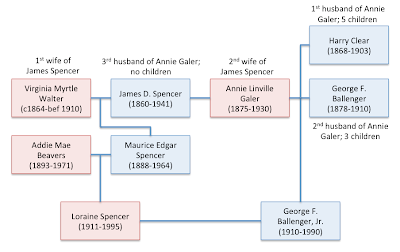- Pinpoints a person and likely their family in a specific place at a particular time that is often in between when the decennial census are enumerated
- Often includes a photograph
- Identifies whether they played sports or joined a club, indicating the interests of an ancestor
 |
| My Aunt Katherine's 3rd cousin; image courtesy of Ancestry.com |
 |
| Husband of Aunt Katherine's 2nd cousin once removed; image courtesy of Ancestory.com |
And my personal favorite from the 1920 Salem College Yearbook, Sights and Sounds:
 |
| My 4th cousin once removed; image courtesy of Ancestry.com |
MAE HAIRSTON, Danville, Va.
Deal little Mae, the youngest member of our class. Smart? Well we'll say she is! Mae hails from Ole Virginia, and a more loyal soul of that dear old state never breathed. Everyone loves Mae; loves her generous heart and unspoiled frankness. Who would dream that in her heart she desires "Rights for women"? Well she does and we're proud of her!
More about Mae
I do have a few issues with how Ancestry.com prompts us to use these sources:
- After reviewing the record, they want to add it to my ancestor's timeline as a Residence fact. Frequently, in a large city that would be correct. If, however, it is a college or university yearbook, then the ancestor's residence is not always the city in which the institution of higher learning is located. This also applies to rural counties. The school may be located in the county seat, but my ancestor lived elsewhere in the county. I would prefer it if the school yearbook source citation would be added to the timeline as an Education fact.
- Ancestry.com is not smart enough to calculate the age based on the grade the person is in when they appeared in the yearbook. Instead, it assumes all people attending school are 16 years old. So do not expect the birth year associated with the record to be extremely accurate.
To search this collection for your ancestors, click SEARCH >> CARD CATALOG from the navigation menu; enter School as your search term; and click U.S. School Yearbooks, 1880-2012. Or from an ancestor's detail page click the Search Records link under their name near the top of the page. Then click Schools, Directories & Church Histories from the Search Categories in the left column.
Happy hunting!
This is my entry for Amy Johnson Crow's 52 ancestors in 52 weeks challenge optional theme School Days.
________________
An Early Feminist of the Very Best Kind






































